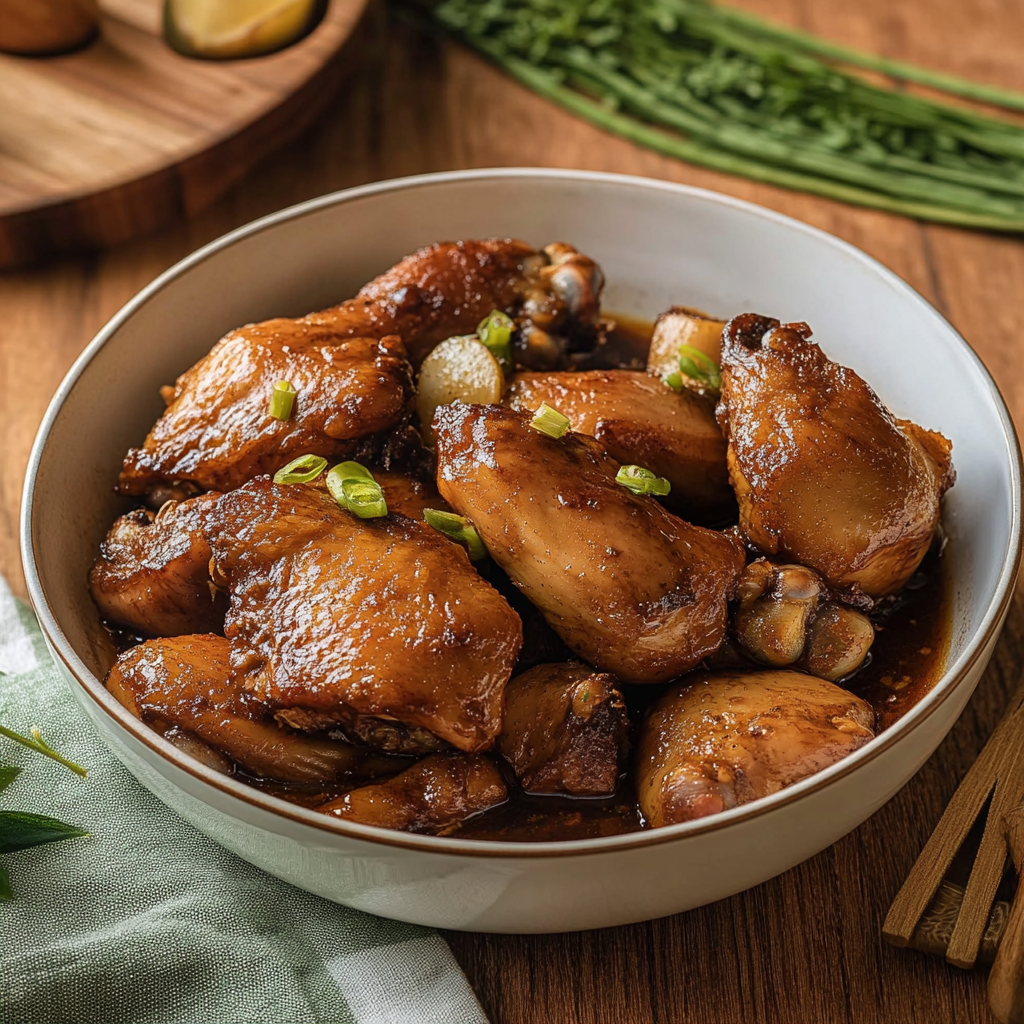Filipino Chicken Adobo is a dish deeply rooted in tradition and history, with a flavor that stands the test of time. The combination of vinegar, soy sauce, and garlic creates an irresistible balance of tangy, savory, and umami-rich flavors that perfectly coat tender, juicy chicken. Simmered to perfection, this dish is both simple and complex, offering a comforting and flavorful meal that’s a staple in Filipino households.
What makes Chicken Adobo so special is its adaptability. While best enjoyed fresh, the flavors deepen overnight, making leftovers even more delicious. Whether served with a steaming bowl of white rice or alongside a vegetable side, this dish is a surefire way to bring bold, nostalgic flavors to the table.
Full Recipe:
Ingredients:
- 2 pounds bone-in chicken thighs or drumsticks
- 1 cup white vinegar
- 1/4 cup soy sauce
- 1 whole garlic bulb, smashed and peeled
- 2 teaspoons kosher salt
- 1 teaspoon coarsely ground black pepper
- 1 bay leaf
- 1 tablespoon canola oil
- 1 cup water
Directions:
- In a shallow dish, combine vinegar, soy sauce, garlic, salt, pepper, and bay leaf.
- Add chicken, cover, and marinate in the refrigerator for 20–30 minutes. Drain, reserving the marinade. Pat chicken dry.
- Heat oil in a large skillet over medium-high heat. Brown chicken on all sides.
- Pour in the reserved marinade and water, bring to a boil, then reduce heat and let simmer, uncovered, for 20–25 minutes, or until chicken is cooked through and the sauce has slightly thickened.
- Remove and discard the bay leaf. Serve warm with steamed rice.
Prep Time: 10 minutes (plus marinating) | Cooking Time: 25 minutes | Total Time: 35 minutes
Kcal: 234 kcal per serving | Servings: 6
The Origins of Filipino Chicken Adobo
The term adobo comes from the Spanish word adobar, which means “to marinate” or “to season.” However, despite its Spanish name, Filipino adobo predates Spanish colonization. Before the Spaniards arrived in the Philippines in the 16th century, native Filipinos already had their own method of preserving meat using vinegar and salt. Over time, soy sauce, a Chinese influence, was introduced into the dish, replacing or complementing the use of salt.
Unlike Spanish and Latin American adobo, which often involves a mixture of spices, Filipino Chicken Adobo is characterized by its simple yet powerful combination of vinegar, soy sauce, garlic, black pepper, and bay leaves. This slow-cooked dish results in tender, flavorful chicken coated in a deeply savory sauce with a tangy punch.
Why Filipino Chicken Adobo Stands Out
One of the most remarkable things about Chicken Adobo is its versatility. While the base ingredients remain the same, families and regions across the Philippines have their own unique variations. Some add coconut milk for a creamy version (adobo sa gata), while others incorporate sugar for a slightly sweet contrast. Some even include chili peppers for a spicy kick.
Another reason this dish is beloved is its ability to develop deeper flavors over time. The acidity from the vinegar helps tenderize the meat, making it even more succulent as it sits. In fact, many Filipinos believe that adobo tastes better the next day, making it an excellent dish for meal prep.
Perfect Pairings for Chicken Adobo
Filipino Chicken Adobo is best enjoyed with steamed white rice, which soaks up the flavorful sauce perfectly. Some also like to pair it with garlic rice (sinangag) for an added layer of aroma and crunch.
For a well-balanced meal, Chicken Adobo can be served alongside sautéed vegetables like bok choy, string beans, or eggplant. Pickled green papaya (atchara) is also a common side dish that complements the tanginess of adobo with its sweet and sour profile.
Tips for Making the Best Filipino Chicken Adobo
- Marinate for More Flavor – While a quick 30-minute marination is enough, allowing the chicken to marinate overnight enhances the flavors, making the dish even tastier.
- Use Dark Meat – Bone-in chicken thighs and drumsticks yield the best results because they stay juicy and tender during the slow simmering process.
- Balance the Vinegar and Soy Sauce – The key to a perfect adobo is achieving the right balance between acidity and saltiness. Some prefer a more tangy flavor, while others lean towards a saltier taste. Adjust the ratio based on personal preference.
- Let the Sauce Reduce – For a richer and more concentrated sauce, allow it to simmer uncovered for a few extra minutes. This enhances the depth of flavor and helps coat the chicken better.
- Customize to Your Liking – Feel free to experiment with additional ingredients like coconut milk, sugar, or chili peppers to create your own signature version of adobo.
Why Chicken Adobo is the Perfect Dish for Any Occasion
One of the reasons Chicken Adobo has remained a beloved dish for generations is its ability to fit any occasion. It’s an excellent choice for a weeknight dinner because of its simple cooking process and minimal ingredients. At the same time, it’s a dish that can be proudly served during special occasions, family gatherings, and even celebrations.
Since Chicken Adobo can be made in large batches, it’s also ideal for meal prepping. It stores well in the refrigerator for up to four days and can be frozen for future meals. The flavors intensify over time, making leftovers even more enjoyable.
Conclusion
Filipino Chicken Adobo is more than just a dish—it’s a cultural icon that represents the ingenuity and resourcefulness of Filipino cooking. Its timeless appeal lies in its simplicity, bold flavors, and adaptability to different tastes and preferences. Whether you’re new to Filipino cuisine or already a fan, Chicken Adobo is a must-try dish that showcases the best of what Filipino home cooking has to offer.
No matter how you prepare it, one thing is certain—Filipino Chicken Adobo will always be a comforting, satisfying meal that brings people together.
